
How to Track a VoIP Number as a Cybersecurity Expert
Voice over Internet Protocol (VoIP) numbers have revolutionized communication, offering affordable, flexible, and global connectivity. As a cybersecurity expert, knowing how to trace a VoIP number can be crucial in cybercrime investigations, fraud detection, and digital forensics.
Can VoIP Calls Be Traced?
Tracking VoIP calls requires skill in network analysis and the power to decode complex data packets. Call logs, IP addresses, and service provider cooperation can be used to detect the caller.
Similarly, law enforcement agencies collaborate with internet service providers to keep track of VoIP calls.
They can ask for subscriber information linked to an IP address for further investigation. A technique called “packet sniffing“ also helps experts intercept VoIP calls.
Data packets are captured as they traverse the network, so packet headers can be inspected and the source/destination IP addresses can be revealed.
A noteworthy case was the capture of a notorious cybercriminal by tracing his VoIP calls. He had been using multiple anonymous phone numbers for unlawful activities.
However, with the cooperation of multiple departments and thorough digital forensics analysis, they discovered the origin of his VoIP calls.
Legal And Ethical Considerations
Legal and ethical considerations are essential when it comes to tracing VoIP calls.
Adherence to legal frameworks and ethical guidelines is paramount to guarantee privacy and safeguard individuals’ rights.
Let’s have a look at the following table to highlight the key points.
Legal Considerations | Ethical Considerations |
| Observe data protection and privacy regulations. | Respect individuals’ privacy. |
| Gain proper legal authorization before call tracing. | Be transparent and inform all parties about the tracing process. |
| Stick to lawful procedures when collecting evidence. | Avoid unnecessary privacy intrusion. |
Tracing VoIP Calls Using Network Logs
Tracing VoIP calls? Network logs can help. They contain valuable info to identify the source and destination of calls. To trace them, create a table with columns such as:
1. Timestamp: Shows exact call time.
2. Source IP address: Reveals origin.
3. Destination IP address: Reveals target.
4. Protocol used: Indicates SIP or RTP call.
5. Call duration: This shows the length of the conversation.
6. Other relevant data: Analyze packet loss, jitter, and latency for better call quality.
An example: Law enforcement used network logs to link a suspect to illegal activities over VoIP calls. Proves the importance of tracing VoIP calls using network logs for investigations.
Obtaining Call Detail Records (CDRs)
To acquire Call Detail Records (CDRs), you must take a professional approach. These records give useful info about VoIP calls , like call duration, time of call, and caller and receiver. Check out the table below for the main columns for CDRs:
| Column Name | Description |
|---|---|
| Call ID | Unique identifier for each call |
| Caller | Person or entity making the call |
| Receiver | Person or entity receiving the call |
| Duration | Length of call in minutes or seconds |
| Timestamp | Exact date/time when the call was started |
Tracing VoIP Calls Using Network Logs
Tracing VoIP calls? Network logs can help. They contain valuable info to identify the source and destination of calls. To trace them, create a table with columns such as:
1. Timestamp: Shows exact call time.
2. Source IP address: Reveals origin.
3. Destination IP address: Reveals target.
4. Protocol used: Indicates SIP or RTP call.
5. Call duration: This shows the length of the conversation.
6. Other relevant data: Analyze packet loss, jitter, and latency for better call quality.
An example: Law enforcement used network logs to link a suspect to illegal activities over VoIP calls. Proves the importance of tracing VoIP calls using network logs for investigations.
Obtaining Call Detail Records (CDRs)
To acquire Call Detail Records (CDRs), you must take a professional approach. These records give useful info about VoIP calls , like call duration, time of call, and caller and receiver. Check out the table below for the main columns for CDRs:
| Column Name | Description |
|---|---|
| Call ID | Unique identifier for each call |
| Caller | Person or entity making the call |
| Receiver | Person or entity receiving the call |
| Duration | Length of call in minutes or seconds |
| Timestamp | Exact date/time when the call was started |
Plus, some systems may have more info like call quality and network data. Be sure you get the needed permissions and legal requirements when obtaining CDRs. This secures privacy and follows rules.
Geo-locating VoIP Callers
Geo-locating VoIP callers are essential. Different techniques and data sources can be used to determine their geographical location.
To geo-locate VoIP callers, several factors must be taken into account.
These include analyzing the IP address associated with the call, examining metadata such as call duration and timestamp, and leveraging databases that link IP addresses to specific locations.
By combining these elements, one can accurately trace the source of a VoIP call.
Here is a table about the key components used:
| Factors | Description |
|---|---|
| IP Address | The unique identifier is assigned to devices connected to a network. Helps identify the caller’s ISP. |
| Call Metadata | Information about the call, such as duration and timestamp, can provide valuable insights. |
| Location Databases | Databases mapping IP addresses to physical locations are needed for tracing. |
To make geo-location more accurate, more details can be considered. This includes voice patterns and accent recognition. Also, cross-referencing with telecommunications providers’ records can yield useful information.
Here are some suggestions for improving geo-location accuracy:
1. Use Advanced Data Analysis: Employ algorithms that can process large amounts of data to enhance accuracy.
2. Partner with Service Providers: Create partnerships with telecommunications companies to gain access to their vast call records.
3. Integrate Voice Recognition Technology: Implement voice analysis software that can recognize regional accents or dialects.
4. Improve Database Accuracy: Regularly update location databases by getting fresh information from reliable sources.
By following these suggestions, organizations can trace VoIP callers more accurately. This ensures better security measures against fraud and malicious activities. Additionally, working with law enforcement can help in VoIP tracing.
Conclusion
We have discussed how to trace VoIP calls and in today’s digital world analyzing network traffic and getting details from service providers makes tracing the source of a VoIP call possible.
SIP headers are important. They contain information like IP addresses and contact details. This helps investigators track where the call is coming from. Manipulating SIP headers can also show security issues.
Going forward, encrypted communication needs to be used. Encrypted VoIP calls offer protection from eavesdropping and tampering. Technologies like TLS and SRTP can make sure conversations remain private.
Mrityunjay Singh
Leave a comment
Your email address will not be published. Required fields are marked *

